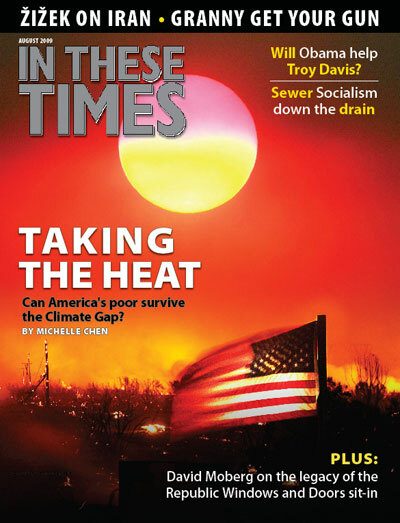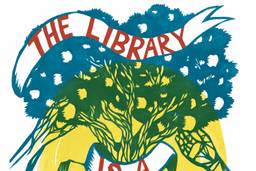Power of the People
In the long run, Iranian civil society will trump both official dogma and international influence.
Aaron Rhodes

Of the many factors that drive events in Iran, three are central to determining the country’s political situation. These factors have been in a state of flux since the June 12 presidential elections, and showed few signs of stabilizing as In These Times went to press in early July.
First, there are the actions of the Iranian authorities and those they control. Second, there is the response of the international community – foreign governments and international organizations. Third, there is the question of what the Iranian people and civil society institutions will do. That last factor is the key to the future of Iran, but it is also the least understood.
The Iranian theocracy is among the most inscrutable structures in the world. Composed of a number of bodies, including the Guardian Council, the Assembly of Experts and the Expediency Discernment Council, it does not operate on models that journalists, political scientists and the international foreign policy establishment can easily understand. With virtually no transparency in the system, news about communications among these bodies is sparse and strictly controlled.
The clerical establishment exerts influence through informal channels. In some ways it resembles one-party political structures like the Soviet Union and the city of Chicago where family histories, bonds, cliques, regional chauvinism and other non-ideological factors hold sway. This externally amorphous and obscure structure, composed of politically brilliant and shrewd men, is itself in a state of flux.
A potentially game-changing reform initiative could come from within the clerical inner circle, which is showing itself, albeit quite discreetly, to be pluralistic. What is now termed a “coup” by the military and security forces has been going on since President Mahmoud Ahmadinejad took power in 2005. At the same time, the years of Ahmadinejad’s presidency have yielded an Enlightenment-style realization: Ambitious, theocratic states that use religious doctrine to govern society often corrupt religious impulses instead of sacralizing the social order.
Is Supreme Leader Ayatollah Ali Khamenei the best person to act as custodian for Shi’ism in Iran and inspire the faithful? Not likely, after his association with the crude political mistakes of his protégé Ahmadinejad, and after displaying a political insensitivity that has led to numerous deaths and countless injuries, engulfing the system in chaos and dragging the image of Iran through the mud.
Iran’s UN allies
The impact of the international response to the crisis has been negligible. Iran has proven time and again to be a state that does not respond predictably to international condemnation or sanctions.
Iran sits comfortably among United Nations member states, including Cuba, Sudan, China and numerous others, that deflect criticism about human rights as politicized interference with their internal affairs. The power balance in the UN makes its institutions slow to criticize the grave and obvious violations of Iran’s human rights obligations during this crisis. When the UN High Commissioner for Human Rights finally issued a statement on June 19, it only referred to “possible illegal use of excessive force,” even though numerous photographs and videos had already shown police and militias brutally beating and even killing demonstrators. When the UN Secretary-General Ban Ki-Moon expressed concern three days later, Iranian officials criticized his statements for having “colonial” orientation.
The United States’ main interest is less about Iran than about partisan domestic politics. The U.S. debate reflects an inflated perception of the United States’ power to influence events abroad. Despite appeals from reform-minded Iranians that they don’t want the United States to publicly take their side as it will undermine their support and allow the government to label them treasonous tools of an enemy state, some members of Congress have persisted in calling for the U.S. president to side with the demonstrators.
President Obama has tried to dodge the dilemma in a way that shows his good intentions, but his statements did not address human rights in international terms, a mistake made by the vast majority of the American foreign policy elite. He did not ask Iran to abide by its human rights obligations under the International Covenant on Civil and Political Rights, but referred vaguely to the universal rights of the people of Iran. It came off as a sermon about right and wrong.
Naturally, Khamenei took the bait, denouncing U.S. concerns for human rights as hypocritical considering American actions in Iraq, Afghanistan and, weirdly, Waco, Texas. The Iranian authorities have claimed that foreign agents and the Mujahedin-e Khalq (MEK) organization, an officially designated terrorist group that has waged armed conflict with Iran since the 1979 Islamic Revolution and recently disarmed, have fomented the mass demonstrations. The label “terrorist” can give license to bypass domestic laws in dealing with threats – real or perceived. But there is no evidence such elements are behind the demonstrations.
Iranian leaders have pretended that foreign governments are instigating the unrest, but the international community has done little to support the protesters. Rather, they’ve mostly provided fodder for propaganda meant to mobilize Iranians against fellow citizens protesting a stolen election.
Civil restlessness
The central question now is who is more willing to tolerate more death, injury and pain at the hands of the security forces and vigilante militias: discontented Iranians or the religious establishment? The latter has the power to replace the Supreme Leader and rerun the elections. However, the military and all security forces in Iran answer to the Leader, which raises the potential for civil war if the elections are redone. The public discontent with the leadership appears to be broad, and it continues to grow as the repression against peaceful demonstrators worsens.
What makes Iran unique among the world’s most repressive states is the development of its civil society. Under former president Mohammad Khatami, the words “civil society” were used so much that they became cliché. Hundreds of organizations and initiatives were formed. Ahmadinejad’s fear of civil society – expressed in the repression of women’s rights, student and labor groups – stems from Iranians’ widespread understanding of the power of organized civil movements.
General strikes were crucial to bringing down the government of the Shah of Iran. Thus, members of women’s groups gathering signatures to change discriminatory laws have routinely been arrested and charged with violating national security. Students have met a similar fate for speaking out about campus issues, and were subsequently beaten, jailed and tortured. Independent labor unions are not allowed to celebrate May Day, much less organize factories, and outspoken labor leaders like Mansour Osanloo languish in prisons.
Of course, human rights activists are among those who have been arrested and detained in the past days. Despite the pressure building on civil society structures for years, these groups form a huge, loosely interconnected and reform-oriented movement that supported opposition candidates Mir-Hossein Mousavi and Mehdi Karroubi. Neither candidate had a natural constituency, and neither impressed the citizens with his charisma or vision. Rather, their support emerged as a function of networks aided by electronic communication.
The civil society movement in Iran is made up of independent groups, individual activists, intellectuals, students, journalists, artists and members of opposition political parties. It answers to no one leader and resists calls for more rigid coordination. Its members have diverse views about the role of religion in society, foreign policy questions and virtually any social and political question, with one major exception: They believe that the government of Ahmadinejad has been brutal, repressive, militaristic and intolerant, and has abused international law. These beliefs have been reinforced by recent events, and will not change, whatever the future brings.
GET INVOLVED:
www.iranhumanrights.orgwww.roozonline.com/english





